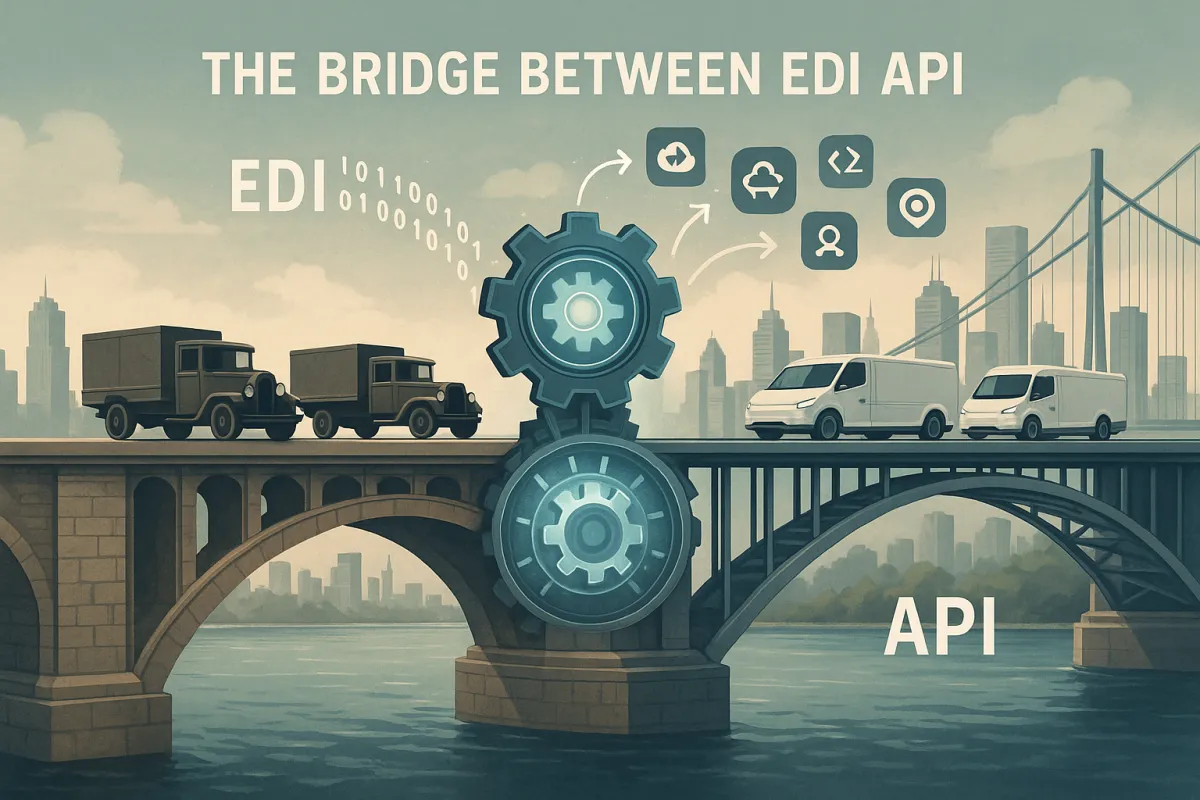Hybrid EDI/API Integration: The Smart Migration Path for Carrier Connectivity in 2025

Most European shippers trying to modernize their carrier connections face the same dilemma: their EDI systems work, but APIs promise faster integrations and real-time data. The solution isn't choosing one or the other – it's building a hybrid EDI/API integration strategy that leverages both protocols while protecting existing investments.
European logistics companies spent decades building reliable EDI connections with hundreds of carriers. Now, with the global EDI software market growing from $2.31 billion in 2025 to $5.30 billion by 2032, these legacy systems aren't going anywhere. Yet APIs offer capabilities EDI can't match. The smart play? Run both, strategically.
Why Hybrid EDI/API Integration Is the Future of Carrier Connectivity
The numbers tell a clear story. New businesses are moving away from batch-based EDI and toward real-time API-based EDI architectures, but they're not abandoning EDI entirely. Instead, this mix of EDI innovations lets businesses keep the structure and rules of EDI while also using the speed and flexibility of APIs.
Consider what's actually happening in the market. EDI integrations may take several months, whereas API integrations can take a matter of weeks, if not days, and integration through APIs is generally less complex than EDI integrations. Yet EDI is still the best, simplest, and most cost-effective way to connect logistics partners and share data, with research showing that EDI has not even reached its full potential in the logistics marketplace.
Here's why hybrid approaches work better than complete migration: A growing trend in supply chain IT is the fusion of traditional EDI systems and modern APIs, as APIs extend existing EDI capabilities with interactivity and integration with cloud-based services, allowing for maintaining critical EDI-based relationships while opening doors to new forms of system interconnectivity.
The technical reality is straightforward. Your largest retail customers aren't switching from EDI anytime soon. EDI is still effectively used today by many large retailers or huge organizations for tasks within transportation such as sending load tenders, status updates, and invoices. But your newer, smaller partners prefer APIs for their speed and simplicity.
The Business Case for Hybrid Over Complete Migration
Cost and risk drive most hybrid decisions. Complete EDI replacement means retraining staff, rebuilding all carrier connections, and risking disruptions with major customers. A large portion of shippers and manufacturers outside Fortune 500 companies still use legacy systems, with companies on average being less than 40 percent digitized according to McKinsey & Co.
The economics favor gradual adoption. Organizations using hybrid approaches can lower operational costs by 30% by combining hyperautomation technologies with redesigned operational processes according to Gartner. This isn't theoretical – it's happening across European logistics operations today.
Meanwhile, solutions like Cargoson offer native support for both EDI and API protocols, while platforms like nShift and Transporeon require partnerships with specialized connectivity providers for comprehensive coverage. The difference in deployment speed and maintenance overhead becomes significant when you're managing 50+ carrier relationships.
Technical Architecture for Hybrid EDI/API Systems
Building systems that handle both protocols requires careful planning. The future of EDI involves supporting integrations across multiple channels, including APIs, ERP, and CRM systems, with prioritizing interoperability ensuring consistent data flow across all platforms.
Your architecture needs three layers: a translation layer that converts between EDI and API formats, a routing layer that determines which protocol to use for each carrier, and a monitoring layer that tracks performance across both. The goal is making protocol differences invisible to your TMS users.
Most European shippers handle this by routing high-volume, scheduled transactions through EDI while using APIs for real-time queries, exception handling, and new partner onboarding. Consider shipping schedules and inventory levels, traditionally managed via EDI – when integrated with APIs, these elements gain real-time visibility and updates, which is a significant step beyond the batch processing of standard EDI.
Solutions vary widely in their hybrid capabilities. FreightPOP and E2open typically require custom development work to bridge EDI and API data flows. Cargoson's platform, by contrast, handles this translation natively, reducing the technical complexity for your IT team.
Data Flow and Message Mapping Strategies
The challenge isn't technical – it's consistency. The same shipment data needs to flow through both EDI batch updates and real-time API calls without conflicts. Your mapping strategy determines success or failure.
Start with your core entities: shipments, purchase orders, invoices, and tracking updates. Map these to both EDI transaction sets (like 214 status updates) and API endpoints. Build validation rules that catch discrepancies between the two data streams before they reach your TMS.
APIs communicate in real-time while EDIs run data transmissions over timers, with APIs transmitting data in milliseconds. This timing difference creates the biggest mapping challenge. Your system needs to handle cases where API data arrives hours before the corresponding EDI batch.
Platforms handle this differently. Descartes and SAP TM require extensive custom mapping for each carrier relationship. Cargoson provides pre-built mappings for common carrier APIs and EDI formats, significantly reducing implementation time.
Implementation Roadmap: 5 Phases to Hybrid Integration
Phase 1: Assessment and Planning (Weeks 1-4)
Audit your existing carrier relationships. Which partners use EDI exclusively? Which offer API alternatives? Document transaction volumes, message types, and performance requirements. Choose a connectivity provider with finance-industry experience – your invoicing and payment processes need bulletproof accuracy.
Phase 2: Core System Integration (Weeks 5-12)
Integrate your chosen platform with your TMS and ERP systems. Set up the translation layer between EDI and API formats. Build monitoring dashboards that show traffic patterns across both protocols. Test with 2-3 low-volume carriers first.
Phase 3: Data Mapping and Validation (Weeks 13-20)
Map your standard business documents to both EDI transaction sets and API schemas. Build validation rules that catch format inconsistencies. Create fallback procedures for when one protocol fails. Document everything – you'll need this when onboarding new team members.
Phase 4: Partner Migration (Weeks 21-32)
Start with carriers that support both protocols. Migrate gradually, running parallel connections until you're confident in data accuracy. Automating the onboarding process for new trading partners is reducing complexity and accelerating integration, with automation tools using pre-built templates and validation processes.
Phase 5: Optimization and Scaling (Weeks 33+)
Monitor performance across both protocols. Identify bottlenecks and optimization opportunities. Scale successful patterns to additional carriers. Build processes for handling API version updates and EDI standard changes.
Timeline varies by provider. Oracle TM and Blue Yonder typically require 6-9 months for full hybrid implementation. Cargoson's pre-built integrations often reduce this to 3-4 months for comparable functionality.
Managing Legacy EDI While Building API Capabilities
Your biggest risk isn't technical failure – it's operational disruption. Keep existing EDI connections running while building API capabilities in parallel. With logistics companies adding more applications and platforms into their digital ecosystems than ever before, ecosystem integration connects a company's key revenue-generating business processes by combining B2B and EDI, data and application integration, and secure file transfer technologies into a single platform.
Run both systems with full data reconciliation for at least 30 days before switching primary data sources. Build automated alerts for discrepancies between EDI and API data. Document rollback procedures – you need fast recovery if API connections fail during peak shipping periods.
The key is gradual transition. Start by using APIs for non-critical functions like tracking queries while keeping EDI for core transactions. As confidence builds, shift more traffic to APIs while maintaining EDI as backup.
Security and Compliance in Hybrid Environments
Running two protocols doubles your security surface area. A common advanced encryption protocol in the EDI world is the Advanced Encryption Standard (AES), which scrambles data into a secret code and unscrambles it when it gets to the right place – it's fast, secure, and used almost everywhere.
APIs require different security models. Most carrier APIs use OAuth 2.0 or API keys for authentication, plus HTTPS for transport encryption. Your hybrid system needs to manage both security frameworks without creating vulnerabilities at the integration points.
The GDPR mandates strict rules on how personal data is processed and protected within the EU and EEA, while regular audits of EDI processes and collaboration with experts to stay updated on regulatory changes are essential practices. Your hybrid system must comply with both frameworks across all data flows.
Solutions like 3Gtms and Shiptify typically require additional security modules for comprehensive compliance. Cargoson builds GDPR compliance and SOX-level audit trails into their core platform, simplifying regulatory management.
Cost-Benefit Analysis and ROI Measurement
Hybrid integration isn't free, but the alternative costs more. Automation is revolutionizing EDI processes by reducing human errors and accelerating transaction times, with AI-driven tools monitoring EDI transactions and automating error handling, allowing businesses to allocate resources more strategically.
Quantify your current costs: manual data entry, error correction, delayed shipments from batch processing delays, and staff time spent managing carrier relationships. Most European logistics operations find hybrid systems pay for themselves within 8-12 months through error reduction alone.
According to a McKinsey analysis, firms that use hyperautomation should expect a 20% to 30% boost in productivity across several business areas, with an IDC report projecting that by 2024, hyperautomation will be an important catalyst of digital transformation.
Compare total cost of ownership carefully. Alpega and Uber Freight charge per transaction across both protocols. Cargoson uses a flat-rate model that becomes more cost-effective as transaction volumes grow. Factor in implementation time, training costs, and ongoing maintenance when calculating ROI.
Future-Proofing Your Integration Strategy
Technology evolution never stops. Artificial Intelligence (AI) and Machine Learning (ML) are being utilized to enhance data accuracy within EDI systems, with these technologies detecting and correcting data anomalies, providing predictive analytics, and optimizing workflows.
The combination of IoT in EDI is changing the way organizations share data and run their operations, with IoT devices collecting real-time data from physical assets like machines, cars, and inventory systems, improving supply chain visibility and reducing manual work.
Choose platforms that can adapt to emerging standards. Blockchain in EDI also lets people track things and see audit trails in real time, which is especially useful in fields like logistics, medicines, and banking where it is important to follow the rules, improving confidence between trading partners.
The smart approach is building systems that abstract protocol differences from your business logic. Whether future carrier connections use EDI, APIs, blockchain, or something entirely new, your core integration patterns shouldn't need complete rebuilds.
Your hybrid EDI/API strategy needs three elements: a platform that handles both protocols natively, processes that maintain data consistency across different timing models, and monitoring that tracks performance regardless of underlying technology. Get these right, and you'll handle whatever comes next in carrier connectivity evolution.
